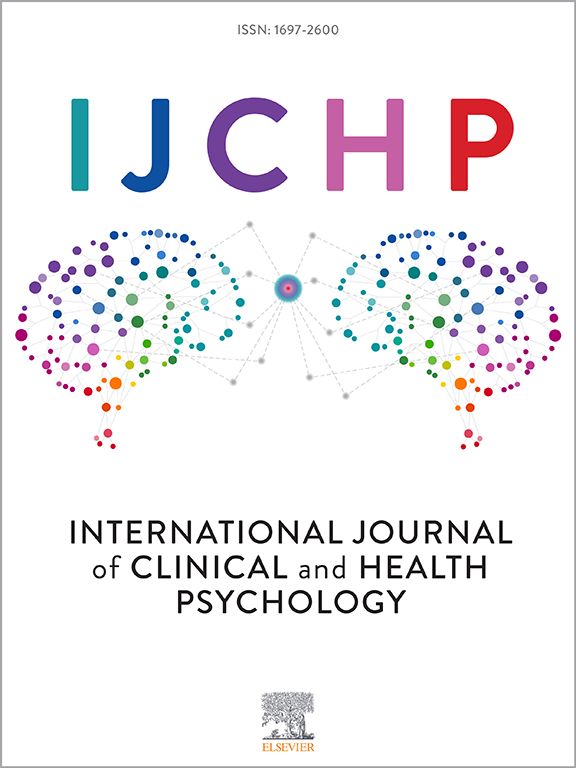Associations of psychological resilience with macro- and microstructures in NREM and REM sleep in adolescents
IF 4.4
1区 心理学
Q1 PSYCHOLOGY, CLINICAL
International Journal of Clinical and Health Psychology
Pub Date : 2025-04-01
DOI:10.1016/j.ijchp.2025.100570
引用次数: 0
Abstract
Study objectives
Previous evidence suggest that sleep contributed to resilience. However, specific sleep markers for resilience in adolescents remain unknown. This study aimed to examine the associations between macro- and microstructures of sleep with resilience in healthy adolescents. This study hypothesized that specific features of both NREM and REM sleep were associated with resilience in healthy adolescents.
Methods
Forty-two healthy adolescents (Mean age: 15.98 years, SD: 2.16 years; female: 57.1 %) were included in this study. Adolescents with any diagnosed sleep or psychiatric disorders were excluded. Participants completed questionnaires that assessed resilience capacity and outcome, childhood trauma, and mental well-being, and underwent polysomnography. Resilience capacity was defined using the score of the Resilience Scale for Chinese Adolescents (RSCA). Resilience outcome was calculated by the residual approach in a linear model using mental well-being (KIDSCREEN) as dependent variable and childhood trauma (Childhood Trauma Questionnaire) as independent variable. NREM and REM sleep macrostructures and microstructures were calculated.
Results
The results showed that higher fast beta power (24–32 Hz) in REM sleep and longer spindle duration in NREM sleep were significantly associated with higher resilience capacity. However, slow wave sleep properties were not associated with either resilience capacity or resilience outcome. In addition, macrostructures of sleep did not differ across resilience groups.
Conclusions
The findings suggest that microstructures of both REM and NREM sleep could serve as biomarkers for resilience. This study could potentially pave the way for prevention and intervention strategies of stress-related disorders in adolescents.
青少年非快速眼动和快速眼动睡眠中心理弹性与宏观和微观结构的关系
研究目标先前的证据表明睡眠有助于恢复力。然而,青少年恢复力的具体睡眠标志仍然未知。本研究旨在探讨健康青少年的宏观和微观睡眠结构与弹性之间的关系。本研究假设非快速眼动和快速眼动睡眠的特定特征与健康青少年的恢复力有关。方法健康青少年42例(平均年龄15.98岁,SD 2.16岁;女性:57.1%)纳入本研究。被诊断为睡眠或精神障碍的青少年被排除在外。参与者完成了评估恢复能力和结果、童年创伤和心理健康的问卷调查,并接受了多导睡眠仪检查。采用《中国青少年心理弹性量表》(RSCA)对心理弹性能力进行定义。以心理健康(KIDSCREEN)为因变量,童年创伤(childhood trauma Questionnaire)为自变量,采用残差法在线性模型中计算恢复力结果。计算非快速眼动和快速眼动睡眠的宏观结构和微观结构。结果快速眼动睡眠较高的快速β功率(24 ~ 32 Hz)和非快速眼动睡眠较长的纺锤波持续时间与较高的恢复能力显著相关。然而,慢波睡眠特性与恢复能力或恢复结果无关。此外,睡眠的宏观结构在适应力组之间没有差异。结论快速眼动和非快速眼动睡眠的微观结构可以作为恢复力的生物标志物。本研究可能为青少年压力相关障碍的预防和干预策略铺平道路。
本文章由计算机程序翻译,如有差异,请以英文原文为准。
求助全文
约1分钟内获得全文
求助全文
来源期刊

International Journal of Clinical and Health Psychology
PSYCHOLOGY, CLINICAL-
CiteScore
10.70
自引率
5.70%
发文量
38
审稿时长
33 days
期刊介绍:
The International Journal of Clinical and Health Psychology is dedicated to publishing manuscripts with a strong emphasis on both basic and applied research, encompassing experimental, clinical, and theoretical contributions that advance the fields of Clinical and Health Psychology. With a focus on four core domains—clinical psychology and psychotherapy, psychopathology, health psychology, and clinical neurosciences—the IJCHP seeks to provide a comprehensive platform for scholarly discourse and innovation. The journal accepts Original Articles (empirical studies) and Review Articles. Manuscripts submitted to IJCHP should be original and not previously published or under consideration elsewhere. All signing authors must unanimously agree on the submitted version of the manuscript. By submitting their work, authors agree to transfer their copyrights to the Journal for the duration of the editorial process.
 求助内容:
求助内容: 应助结果提醒方式:
应助结果提醒方式:


